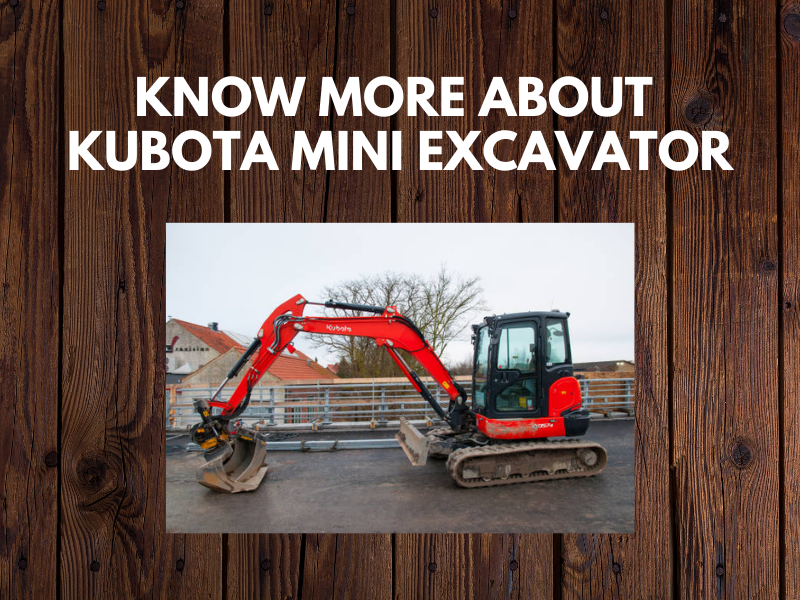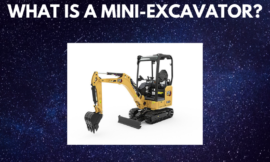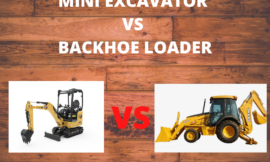What’s a Kubota Mini Excavator
A Kubota mini-excavator is a small excavator that is designed by the Kubota company.
The headquarters of the Kubota company is now situated in Osaka, japan
A Kubota compact excavator weighs less than 10,000 pounds. It comes with a dipper, boom, and a bucket. It also comes with a rotating cab that allows it to rotate 360 degrees.
A Kubota Mini excavator uses hydraulics to power the boom, dipper, etc.
It has hydraulically powered attachments.
The machine retracts its under – carriage when used in tight spaces .
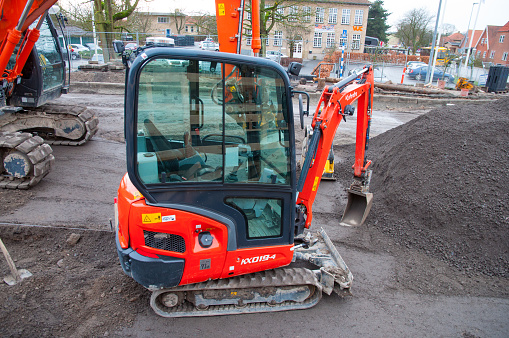
Categories of Compact Excavators are :
- Max dig depth : How much the bucket can dig below the machine
- Max cutting height : How high the bucket can go
- Power rating : How much power the excavator’s engine can generate
When it comes to heavy-duty diggers, you can’t do better than excavators. From large-scale projects like mining, rock blasting, pile-driving to small-medium scale digging projects like landscaping, digging trenches, excavating roads, and snow-clearing.
But what if you are dealing with a tight space, or you are dealing with a tighter budget? Then, a compact excavator would do just perfectly.
Not only do small excavators like Kubota Mini Excavators offer lots of power in a small machine, but their small size also makes them easy to move and to transport across the worksite.
Compact excavators are very useful for situations where you would be moving around a lot with the excavator.
Like their larger counterparts, Small excavators are compatible with a large number of attachments this increases the amount of work they can perform.
While they are lots of manufacturers that produce compact excavators, not all of them are high-quality. However, one manufacturer of high-quality mini-excavators is Kubota.
Uses Of a Kubota Mini Excavator :
They are several uses for a compact excavator. Some require additional attachments while others don’t. The most common uses of a small excavators include :
- Digging: Being an excavator, digging is the main job of a compact excavator. Excavator Buckets are used for digging . Depending on the terrain, however, you might need specialized buckets.
- For example, Heavy-Duty buckets are seen in action for rock dense areas .
- Small scale demolition : compact excavators are also good small scale demolition jobs. They are great because they can fit into small spaces and remove dirt and debris easily.
- Landscaping : Landscaping is another area where compact excavators perform very well.
- For example, compact excavators are good at clearing overgrown weeds and lawns, especially when brush cutters are attached to the excavator.
- Forestry : small excavators are used to clear stumps and remove logs in forests. Their small size allows them to maneuver easily without doing much damage to the terrain.
- Plumbing : compact excavators is perfect for plumbing because they can work with small spaces. Their small size makes it easy for your backyard to accommodate a compact excavator
- Waste and Recycling : Thanks to their small size, compact excavators are used to excavate waste materials and landfills without worrying much about their small size, unlike medium to large excavators.
- Snow Clearing : small excavators do well in the snow, thanks to their size.

Attachments of a Kubota Mini Excavator
One major benefit of compact excavators is their versatility. The types of work a small compact excavator can do depend on the current attachment it’s using.
The Most Common attachments of the Kubota Mini Excavator are :
Trench bucket
compact excavators can dig trenches very effectively, whether narrow or deep trenches. All you need is to attach trench buckets to the machine.
You can also add other accessories to increase the durability of the buckets. Trench buckets go for as much as $700 – $300.
Augers
When you need to dig holes for trees, poles, fence-posts, etc, then an auger is the attachment that you need.
For difficult positions like working from the side An Auger. An auger would cost you around $1,200 to $3,000.
Thumbs and Clamps
Sometimes, you need to lift debris or other material that would have a hard time fitting into the bucket. So you need to attach thumbs and clamps that would hold those objects in place while you are moving them.
Hammers
Buckets can’t dig through solid rock, and so, in such a situation, a hydraulic breaker is suitable. Hammers, sometimes called breakers, pound on the material just like a hammer.
New hydraulic hammers come with newer technology that makes the breaker more efficient.
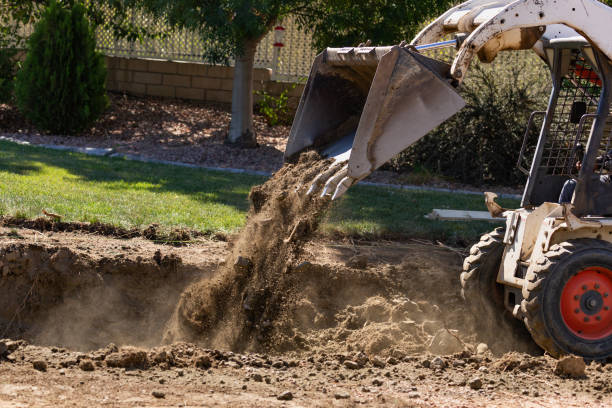
Heavy-duty bucket
Another major attachment used with compact excavators is heavy-duty buckets. Heavy-duty buckets are what you turn to when you need to dig areas that are very hard to break down.
A good example would be an area that is filled with rocks. Such an area would easily wear out a regular bucket or a trenching bucket.
Heavy-duty buckets should cost you around $2,000 – $6,000.
Quick Couplers
These attachments make it easier to fit other attachments onto the compact excavator. With quick couplers, all you need to do when you want to change attachments is to push a button.
You should expect to pay between $30 – $200.
Stump-grinders
If you’ll be using a small excavators for agriculture or landscaping projects, then chances are that you’ll likely need a stump grinder.
Sometimes called mulchers, stump grinders are perfect for clearing stumps, bushes, overgrown hedges, etc.
A stump grinder costs as much as $1,500 to $6,000 for small sizes and $9,000 to $20,000 for larger sizes.
Rakes
This is another attachment commonly used in agriculture and forestry projects. Rakes are typically used to clear rocks and other debris from the site.
They can also be used to prepare the ground for agriculture purposes. You should expect to spend $200 – $600 if you want a small rake, and $800 – $2,000 if you want a bigger rake.

Shears
Shears are mostly used in demolition jobs where they are used to tear down concrete structures, steel buildings, etc.
They can also cut through wires and metal poles. A typical small size shear should cost you between $1,500 to $3,000, while bigger sizes start from $8000 and move upward to $22,000.
Tilt Buckets
Another very useful attachment for compact excavators is the tilt bucket.
Hydraulically powered tilt buckets are used in trenching jobs to keep the trench level because they can tilt 45 degrees in either direction. You should expect a tilt bucket to cost as much as $500 – $2,000.
Grading buckets
Another bucket commonly attached to compact excavators is grading buckets. They can be used for several things including backfilling, leveling, finish grading, etc
Water Mist
This attachment is concerned with the safety of the workers at the site. They work by spraying water in the air to suppress dust, silica, and other harmful particles that might be in the air.
This is in strict line with the OSHA policy.
Drum-cutter
When you need to break and excavate through solid rock, then a drum cutter is the attachment you turn to. They are also commonly applied in other construction jobs like trenching, laying foundations, dredging, etc.
It is common to use a water mist and other similar attachments to suppress the dust and silica being released during the excavation work.
You should expect a drum cutter to cost around $8,000 to $10,000 for the small sizes, while large sizes should cost around $24,000 to $42,000.
Kubota Mini Excavators In Action
Advantages of A Kubota Mini Excavator
There following are some advantages to using a compact excavator :
Compact size
Thanks to their small size, compact excavators can do heavy-duty work in tight and confined spaces. Mini-excavators can be used in interior demolition.
They are also good at working on narrow roads. Thanks to their “Zero tail swing”, they can work beside buildings without causing any damage.
Fuel efficiency
small excavators uses less fuel than other construction machinery. This is particularly useful if you are trying to be environmentally friendly.
Cost-efficient
Thanks to their fuel efficiency and their versatility, compact excavators are more cost-efficient than regular excavators.
Mini Excavator With The Hammer Attachment In Action
How To Know If A Kubota Mini Excavator is Right For You
Now, after understanding what a Kubota mini excavator is and seeing all its uses, you might wonder if it’s right for your project.
While compact excavators are small, powerful, and easy to move, whether they are perfect for you will depend on your particular situation.
Here are some things to consider before choosing which machine to go for :
Size :
The first thing to consider before choosing which heavy-duty machine like a Kubota Mini Excavator is good for you is the size of your project. If your project is large e.g you need to clear a forest, or a mine site, then you’d be better off using a regular size excavator.
However, if your project size is not big, then a compact excavator would be perfect. However, if you have a large project, but a very tight budget, you can still go for a compact excavator, although it’d take more time to get the work done.
Space
How much space you have at the work site should be considered before you choose which machine to go with.
If you have a large amount of space I.e a large open space to work with, then you can go ahead and opt for a regular excavator.
However, if your space is constrained, e.g narrow roads, close to buildings, etc then a mini-excavator would be your best friend as it can maneuver easily through tight space.
Plus, small excavators come with a Zero-tail swing which allows the machine to swing with its tail becoming an obstruction.
Budget
Your budget is another huge factor to consider before choosing a heavy-duty construction machine. How much you have, both for the machine and its maintenance (including fuel) will inform your choice of machinery.
If the budget is tight, then a small excavators would be a perfect option. However, if you have a larger budget, and your project requires more than a mini-excavator, then you would do just fine with a regular excavator.
Transportation
You also need to take into account how often you’ll need to transport the machine. Thanks to their small size, transporting small excavators costs less than transporting regular-sized excavators.
Storage
How much storage space do you have? small excavators can easily fit into buildings and small spaces, and so they’ll be a perfect option if you have a very small storage space to work with.
Time
What is the time frame for the completion of your project. While they are mostly the same, small excavators generally take more time than regular excavators to complete the same task.
If you have a tight deadline, then you can opt for a larger excavator. However, if you have lots of time on your side, then a mini-excavator won’t be a bad option.
Talk to a construction expert :
If you are unfamiliar with construction projects, then you might have a hard time picking which machine is best for your particular situation I.e time, budget, space, etc,
Talking to a construction expert would solve that problem for you. Not only would a construction expert help you choose which machine is the best, but they’ll also provide tips on how you can save money on your project while delivering the best work.
A construction expert can also help show you how to employ qualified machine operators. The last thing you would want is to have an inexperienced/unqualified operator handling your machine.
Kubota Mini Excavator vs a Backhoe Loader
There is another small compact machine used commonly on construction sites :
the backhoe loader. While a back-hoe shares similar benefits with a small excavators, some differences make one more suitable than the other, depending on your particular requirements.
The following are the major differences between a mini-excavator and a backhoe loader :
- Shape : Small excavators like the Kubota Mini Excavator feature a bucket on the front end that is used to dig. A backhoe loader, on the other hand, features both a front loader and a bucket loader. Small excavators are also smaller than backhoe loaders.
- Transportation : small excavators mostly come with tracks, and for that reason, a carrier vehicle is used to transport the Kubota mini excavator to the work-site. Backhoe loaders, on the other hand, come with tires. They can even be driven on public roads at a max speed of 25 miles per hour.
- Rotation : small excavators is capable of rotating a full 360 degrees. This allows the machine operator to work at different angles without having to reposition the machine every time and that saves time and fuel. A backhoe, on the other hand, can only rotate its arm 200 degrees.
Conclusion
While mini-excavators are extremely popular, they might not be the best for your project. However this article aims to cut out the confusion involved in choosing what machine best suits your construction project.
Mini excavators are best suited to smaller budgets, smaller space, and smaller projects. If you are not constrained by any of the following, you can opt for a larger size excavator, or a backhoe loader.
Finally, if you are still having any confusions, then you should contact a construction expert as their advice will help you understand your project’s requirements properly, and also show you how to choose the best machine.


